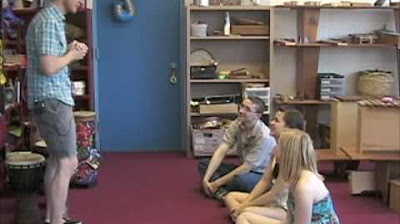Rhythm in music explained- How to get rhythm
Summary
TLDRIn this video, Rory, a percussionist and composer, explores the concept of rhythm and its development. He believes everyone has an innate rhythmic ability that can be enhanced like a muscle. Rory introduces exercises using a metronome and language to build an internal sense of rhythm, emphasizing the importance of practice, audiation, and synchronizing movement for musicality.
Takeaways
- 🎶 Rhythm is a natural ability that can be developed like a muscle, and everyone has it.
- 🕒 Time is a fundamental element in rhythm, as music exists in time unlike other art forms.
- 💡 The beat is the foundation of rhythm, and a metronome is a useful tool to develop a sense of pulse.
- 📈 Metronome speed is measured in beats per minute (BPM), and digital metronomes are accessible through apps and web browsers.
- 📚 Rhythm can be thought of like language, with syllables corresponding to beats in a musical pulse.
- 📝 Practicing rhythm involves vocalizing rhythms, counting out loud, and synchronizing cognitive movement.
- 🎵 Words with different syllable counts can be used to practice rhythm, starting with simple words like 'coffee' and progressing to more complex ones.
- 🎹 After vocalizing rhythms, practice playing them on an instrument or clapping to internalize the rhythm.
- 🚶♂️ Walking is a common cadence for movement, similar to counting numbers, and can help in developing an internal sense of rhythm.
- 🤔 Audiation is the scientific term for thinking rhythms in our head, which is crucial for developing an internal sense of rhythm.
- 🌐 Different languages and music styles have unique cadences, reflecting the diversity in rhythmic expression.
Q & A
What is the main focus of the video?
-The main focus of the video is to explore the concept of rhythm, how it can be developed, and how it can be learned to improve musicality and consistency in music.
What is the speaker's belief about rhythm and its relation to everyone?
-The speaker believes that everyone has rhythm and that it is like a muscle that needs to be developed, similar to how we learn and develop different languages.
What is the definition of rhythm as mentioned in the video?
-Rhythm is defined as a sound or event that repeats regularly over time, with time being the crucial element as music exists in time.
What is the relationship between beat and rhythm?
-The beat is at the heart of rhythm. A single beat that repeats at regular time intervals is called a pulse, which is the foundation on which rhythm is played.
What is a metronome and how is it used to develop rhythm?
-A metronome is a device that produces an audible click at regular time intervals, which can be adjusted in speed (measured in beats per minute, or BPM). It is used to develop a sense of pulse and practice rhythms at different tempos.
How can language be used to develop rhythm?
-Language can be used to develop rhythm by applying the principles of language to building rhythms. Words can be broken down into syllables and applied to a musical pulse, creating a rhythm.
What is the term 'audiation' and how does it relate to rhythm?
-Audiation is the musical equivalent of thinking in language. It involves vocalizing rhythms in our head, which helps develop an internal sense of rhythm and is crucial for playing rhythmically.
What is the common cadence across all accents in all languages that can be used to develop rhythm?
-The common cadence across all accents in all languages is the pattern with which we are taught to count numbers, which can be used to develop an internal sense of pulse.
What is the purpose of practicing with a metronome?
-Practicing with a metronome helps to identify a solid, fixed pulse, which is essential for building rhythms and developing a consistent sense of timing in music.
How can body percussion be used to develop an internal sense of rhythm?
-Body percussion, such as stomping, tapping knees, or clapping, can be coordinated with a pulse to practice rhythmic movement. This helps develop coordination and control, crucial for playing rhythmically and in time.
What is the importance of counting out loud while practicing rhythm?
-Counting out loud while practicing rhythm helps to develop an internal metronome or sense of pulse. It is a simple method for practicing simple rhythms and can be more challenging for complex ones.
Outlines

Cette section est réservée aux utilisateurs payants. Améliorez votre compte pour accéder à cette section.
Améliorer maintenantMindmap

Cette section est réservée aux utilisateurs payants. Améliorez votre compte pour accéder à cette section.
Améliorer maintenantKeywords

Cette section est réservée aux utilisateurs payants. Améliorez votre compte pour accéder à cette section.
Améliorer maintenantHighlights

Cette section est réservée aux utilisateurs payants. Améliorez votre compte pour accéder à cette section.
Améliorer maintenantTranscripts

Cette section est réservée aux utilisateurs payants. Améliorez votre compte pour accéder à cette section.
Améliorer maintenant5.0 / 5 (0 votes)






